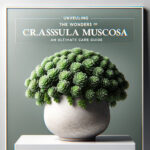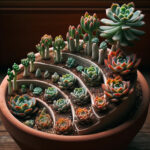Welcome to the captivating world of Crassula Perforata! If you’re intrigued by the idea of introducing some greenery into your indoor decor, but aren’t exactly blessed with a green thumb, this plant is totally your jam. It’s a conversation starter, a head turner, and above all, an excellent house plant.
So, What Exactly Is Crassula Perforata?
Commonly known as “String of Buttons”, “Pagoda Plant”, or “Stacking Crassula”, Crassula perforata is an intriguing succulent that boasts an interesting mix of aesthetic appeal and easy care. Native to South Africa and part of the large Crassulaceae family, this plant gets its peculiar name from its disc-like leaves that stack one upon another, perforating the stem in a stunning alternating pattern.
But, What Makes Crassula Perforata So Special?
Besides its architectural form, Crassula perforata is also known for its adaptability. It’s often found gracing on window sills, bookshelves and office desks, where its delightful appearance enlivens the space while also acting as the perfect antidote to mundane routines. But let’s put the brakes on the details here. Stick around and you’ll discover a whole lot more about this plant’s unique allure and why it’s such a popular choice for houseplants. Get ready to delve deep into the fascinating world of Crassula perforata!
Let’s dive into the captivating world of Crassula perforata, a charming, low-maintenance houseplant that is sure to add vivacious vitality to your home decor.
Size and Color of Crassula Perforata
Standing proudly at a height of one to two feet, Crassula perforata is an impressively robust succulent. This isn’t a green giant, but its size is perfect for adding a green touch to your desk or windowsill. The leaves of Crassula perforata bring a refreshing two-tone blend to the table. Predominantly green, they often sport red hues towards their tips, especially when exposed to the bright sunlight they love so much. This color interplay brings a visually pleasing contrast that can brighten any corner of your home.
The Signature Leaves of Crassula Perforata
What sets Crassula perforata apart are its fascinating leaves. They are triangular in shape, have a fleshy texture and are stacked in an overlapping pattern that spirals up the stem. This unique arrangement, where the stem appears to ‘perforate’ the centers of the leaves, gives the plant its name, Crassula perforata, often colloquially referred to as ‘String of Buttons’ or ‘Necklace Vine’. Isn’t the nomenclature quite the conversation starter at your next dinner party?
Flowers: The Hidden Charm of Crassula Perforata
Hold on, the beauty extends beyond the leaves. Come spring or early summer, you might just get a delightful surprise. Crassula perforata blooms, albeit infrequently, with small, dainty, star-shaped flowers. These unscented, white or pale yellow blossoms are a joyous addition to the chunky leaves, offering another captivating contrast that Mother Nature seems to be so fond of.
The Growth Pattern of Crassula Perforata
Last, but certainly not least, let’s chat about the growth pattern of Crassula perforata. It grows in a shrub-like manner, its stems branching out, growing upwards and sideways. It’s a moderate grower, neither too fast nor too slow, ideal for someone seeking a houseplant which doesn’t demand constant care. And, get this, it’s a perennial succulent. Thus, once within the cozy confines of your home, you’ll have Crassula perforata as a long-term green companion. A plant BFF, if you will.
So there you have it, a close look at the irresistible charms and physical characteristics of Crassula perforata. Is there any wonder why it’s a favorite among houseplant enthusiasts?
Let’s embark on a journey into the botanical backstory of the Crassula Perforata. If you’ve ever thought, “where does my delightful little house plant originate from?” then you’re about to uncover some fascinating insights. Buckle up, as we dive into the world of this succulent’s roots – literally and figuratively.
The Birthplace of Crassula Perforata
Crassula Perforata, also fondly called “String of Buttons” due to its unique look, springs from the vibrant and diverse landscapes of South Africa. Like a treasure hidden within the arid labyrinth of the continent, the succulent takes its birth in the heart of the Cape of Good Hope. The evolution of Crassula Perforata in such a unique environment ensures it’s a hardy little plant indeed!
From African Plains to Global Stardom
South Africa’s Kaleidoscopic ecosystem blessed Crassula Perforata with the adaptability it needed to conquer terrains far and wide. Over time, this succulent found its way around the globe, particularly making a name for itself in horticultural circles and house plant enthusiasts’ collections. Thus, you could be somewhere in Ohio or Osaka – you’re just as likely to find Crassula Perforata turning heads and catching eyes.
Thriving in the Wild
The natural habitat of the Crassula Perforata is as captivating as the plant itself. Picture this: it thrives in rock crevices and on quartz patches, basking under the warm, African sun, and nestling itself amidst the cool, rocky shades. For awareness, quartz patches are not your average garden soil; they’re arid, mineral-rich, and surprisingly hostile to most plants. But not to our little hero, the resilient Crassula Perforata.
Transcending Geographic Boundaries
The Crassula Perforata isn’t a stay-at-home type; it’s a cosmopolitan adventurer. Gardeners and conservationists may find this succulent in various corners of the world; it’s a versatile showstopper that’s very happy to find itself in a plethora of environments. From amateur pot plants in suburban windowsills to prestigious conservatories’ collections, Crassula Perforata has genuinely transcended its geographical boundaries to become a beloved, global house plant.
So there you have it! A tale of how the Crassula Perforata bloomed from the heart of South Africa and ventured across the globe, gracing homes and gardens with its distinctive presence. It truly does make for an excellent house plant, doesn’t it?
Growing Crassula Perforata at Home: A Practical Guide
If you’ve ever wanted to add a unique touch to your indoor garden, chances are you’ve considered Crassula Perforata. Also known as String of buttons, this charming succulent not only beautifies your space but requires minimal care. Here’s your comprehensive guide on growing and caring for Crassula Perforata at home.
Ideal Soil for Crassula Perforata
Like most succulents, Crassula Perforata does well in well-draining soil. Special succulent or cacti mix works best, or you can make your own by mixing potting soil with sand or perlite in a 1:1 ratio. This type of soil prevents water clogging, reduces root rot risk, and mimics the plant’s natural arid habitat.
Light Requirements
When it comes to light, Crassula Perforata loves a generous dose of it. Place it in a spot that receives plenty of indirect sunlight. If you live in a low light area, a grow light can do wonders. Too much direct sunlight might scorch the leaves, while too little might result in a leggy plant.
Temperature Tolerance
Crassula Perforata is pretty hardy and adapts well to indoor temperatures. It thrives best between 15-26°C (60-80°F). It can tolerate mild frost, but prolonged exposure to temperatures below 10°C (50°F) can be harmful. If it’s too cold outside, bring your plant indoors for its survival.
Watering Crassula Perforata
One of the beauties of having a Crassula Perforata is that it doesn’t need constant watering. In fact, overwatering is more harmful than underwatering the plant. It prefers a ‘soak and dry’ method. This means you should only water the soil thoroughly and wait for it to dry out completely before watering again. In winter, watering needs reduce significantly.
Growing Crassula Perforata at home doesn’t have to be a daunting task. With the right mix of soil, light, temperature, and water, you can transform your indoor gardening experience and enjoy the beauty this plant endows. Remember, the best caretaker’s secret lies in understanding the plant’s needs and responding accordingly.
Let’s get into the nitty-gritty of Crassula perforata care. Like any living thing, this nimble plant may encounter some hurdles on the path to full, leafy glory. But don’t you worry! We’re going to arm you with know-how to tackle a range of potential problems effectively.
Pests: The Unwelcome Visitors
So, your Crassula perforata appears to have some unexpected guests. This could be irritating for both you and your plant. Common pests infesting this plant species may include mealybugs and spider mites. Mealybugs, those tiny cotton-like blobs, enjoy making a meal of your plant’s juicy parts. Spider mites, on the other hand, are notorious for crafting fine, spiderweb-like threads all over the plant. Not exactly the decoration you’d hoped for your green companion, right?
Getting Rid of the Pests
Now, here’s what you can do: as a first step, try wiping your Crassula perforata with a soapy mix or insecticidal soap. Gently focussing on affected areas usually does the trick. If the infestation persists, a targeted pesticide can also be a potent weapon. However, remember to always opt for organic and plant-friendly ones. You don’t want to replace one problem with another.
Diseases: The Invisible Battle
At times, your Crassula perforata might be at war with diseases. Fungal rots and bacterial infections, generally resulting from improper watering practices, can mar the health of your plant. Over-dampness breeds these enemies that can cause leaf spots, wrinkling or discoloration.
Fight Back Against Diseases
To ensure your plant can fight off these diseases, regulate your watering schedule. Watering should only be done when the topsoil is completely dry. This makes sure your Crassula perforata can breathe and thrive. It might also be helpful to repot the plant if the infection is severe. Use fresh, well-draining soil and a clean pot.
Environmental Challenges: The Silent Stressors
Environmental factors can also stress your Crassula perforata. Extreme temperature changes and inadequate light are common stressors. Extended exposure to direct sunlight can burn the leaves, while insufficient light can lead to etiolation (the stretching of plants).
Harmonising the Environment
Always remember, Crassula perforata prefers a stable environment. Keep the plant in an area with plenty of indirect light. Rotate it regularly to ensure all parts get an equal share of light. If the temperatures in your region fluctuate wildly, keep the plant indoors near a window that receives lots of bright, filtered light.
To sum it up, caring for Crassula perforata can occasionally involve minor hurdles. However, equipped with the right knowledge and a keen eye, you will be able to triumph over these challenges and help your plant flourish.
Propagation Methods for Crassula Perforata
If you’ve ever daydreamed about having your own magical green space filled with your favorite plants, propagating your Crassula perforata can help bring that dream to life. Imagine having dozens of the charmingly unique ‘string of buttons’ growing in different pots, all originated from a single parent. Well, it’s not rocket science! You’ll be amazed at how simple it is to multiply your crassula family, whether through cuttings, division, or even seeds. Let’s get into it!
Propagating Crassula perforata Cuttings – The Go-To Method
Taking cuttings is undoubtedly the most common route for propagating Crassula perforata. It’s easy and gives reliable results. If you’ve never tried it before, there’s no need to be nervous – it’s almost as straightforward as cutting a slice of pie!
To start, use a clean, sharp knife or shear to cut a healthy stem or offshoot from your Crassula perforata parent plant. Remember to make your cut just below a node, the point where leaves attach to the stem. After that, you’ll need to let your cutting dry out for a few days to avoid rot when planting. Once the end has calloused over – pop it in well-draining soil, give it a good watering, and you’re done! Wait patiently, and with right care, you’ll see new roots forming in no time.
Division – The Shortcut for Crassula perforata Propagation
If you want to amp up the growth rate, division might be the perfect propagation method for your Crassula perforata. This method is akin to moving in with a best friend – you already know they’re a good fit! Here’s how you do it:
Gently remove your Crassula perforata from its pot and get a good look at the root system. If you notice several clusters of roots, you’ve hit the jackpot! Now, carefully separate the plant at the roots using a clean sharp knife, ensuring each division has a decent amount of roots. From here, simply repot your new plants into their new homes, water them, and let them thrive!
Propagation from Seeds – The Long Haul
If you’re more of a patient gardener who enjoys watching the slow magic unfold, propagating Crassula perforata from seeds will be right up your alley. The process demands time, but there’s nothing quite as rewarding as fostering life in its purest form.
Begin by scattering your Crassula perforata seeds over the well-draining soil and lightly covering them. Ensure the soil stays relatively moist but be careful not to overwater and drown the seeds. It takes a good amount of patience to wait for the seedlings to push through the dirt, but trust me, the first sight of those little green babies will make your heart swell!
So, there you have it, three different ways to propagate your Crassula perforata! Whether you’re a novice or a seasoned plant parent, the joy of propagation is universal. It’s a build-your-own-adventure kind of journey – so turn up your sleeves and jump into the wonderful world of Crassula perforata propagation!
Experience the Beauty of Crassula Perforata in Your Home
There’s a good reason why Crassula Perforata, commonly known as the “String of Buttons,” has gained popularity among the indoor plant community. Start with its aesthetic charm: With fascinating concentric leaf patterns and a cascading growth habit, this plant effortlessly adds an element of visual interest and sophistication to your living space. But its beauty is more than just skin-deep. As it turns out, this stand-out succulent also offers certain health and wellness benefits that you may have overlooked.
Crassula Perforata: A Natural Air Purifier
Did you know that your Crassula Perforata might be silently protecting you from harmful indoor pollutants? According to research from NASA, plants like the Crassula Perforata have the ability to filter and purify the air in your home. It works tirelessly to eliminate toxins present in your indoor environment, making the air you breathe purer and healthier. If you’re particular about indoor air quality, having this succulent in your dwelling will be beneficial.
Reduction of Humidity Levels
Another significant benefit of Crassula Perforata is its ability to balance indoor humidity. It’s a fact that high levels of moisture inside a home can lead to problems like mold and mildew. Luckily, Crassula Perforata can help. As a succulent, it naturally absorbs excess water from the atmosphere around it, which helps to keep your home’s humidity levels in-check. Plus, it’s a great ally against those sweltering, sticky summer days.
Boost Your Home Décor with Crassula Perforata
No matter what your style is, the Crassula Perforata can progressively enhance your décor. Placed over a high shelf, it can make a perfect natural curtain. Paired with other colorful succulents, it can create a vibrant centerpiece. For minimalists, a single plant in a sleek pot can make a clean, modern statement. Indeed, the Crassula Perforata is an easy, low-maintenance way to add some much-needed greenery and polish to your home interior.
Optimize Space with Its Compact Size
Crassula Perforata’s compact size also works to its advantage in a home setting. If you’re living in a smaller home or apartment with limited space, you don’t need to give up on your dream of having houseplants. Crassula Perforata can thrive even in cramped corners. Its flexibility and adaptability mean that it can easily fit into any available space, making it the perfect plant for urban dwellers looking to bring some nature indoors.
In conclusion, the benefits of having a Crassula Perforata at home go beyond its looks. This plant delights the eye, cleans the air, keeps your home’s humidity in balance, and gives your décor a unique and appealing spin. It’s a testament to the fact that good things indeed come in small – or in this case, potted – packages!
Frequently Asked Questions About Crassula Perforata
If you’re thinking about bringing a Crassula Perforata plant into your home, you probably have a few questions. Well, you’re in the right spot! We’ve compiled the most frequently asked questions about this remarkable house plant, so let’s strike up a conversation!
Can Crassula Perforata Grow Indoors?
Well, hello indoor jungle, here we come! Crassula Perforata is a type of succulent, which means it’s a strong, robust plant made for indoor life. They’re ideal housemates, adjusting well to room temperature and annoyingly forgetful plant parents (yes, we all forget to water at some point). They even like to sunbathe near bright, sunny windows. So yes, your Crassula Perforata will flourish indoors.
Is Crassula Perforata Toxic To Pets?
As much as we adore our furry friends, they can often have an insatiable curiosity for chewing houseplants. But let’s cut to the chase — is Crassula Perforata safe for pets? Unfortunately, the answer is no. If ingested, this plant could cause mild to moderate gastrointestinal upset for both dogs and cats. So, if you have a frisky feline or curious canine, it might be best to place your Crassula Perforata truly out of reach – maybe your home office desk?
How Often Should Crassula Perforata Be Watered?
Watering Crassula Perforata is like watching that one TV show where you wait for the final season far too long – patience wins the game. You see, these succulents need their soil to dry out completely between waterings. Depending on your home’s humidity, that could mean watering only once or twice a month. Think of it like this – allowing its soil to dry is like giving the Crassula Perforata a mini-desert experience right in your living room.
A Final Thought on Crassula Perforata
Having a Crassula Perforata in your abode can definitely up the plant game. Its unique design, ease of care, and ability to thrive indoors make this plant an excellent choice for any plant parent. Just remember to keep it out of reach from your adorable pets and don’t drown it in water!



